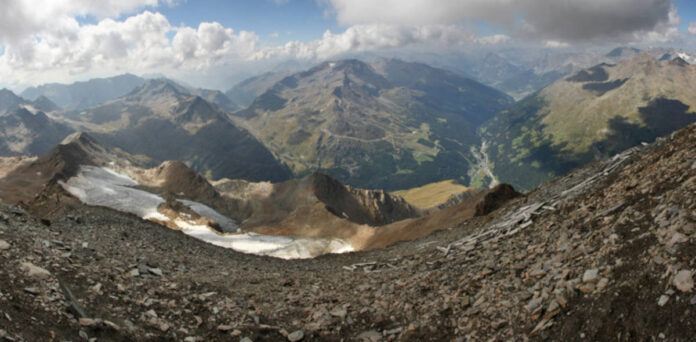A series of petroglyphs have been identified in the Alpine Lombardy region at over 3,000 meters (9842 feet), more than 7 years after they were found by a hiker from Como. Found on Pizzo Tresero (Valfurva) within the Stelvio National Park, the strange carvings were at the foot of the glacier of the same name. Radiocarbon dating and analysis pointed too the petroglyphs dating to the Middle Bronze Age, between 3,600 and 3,200 years ago.
The location is currently a historical hotspot, as another paleontological find has just been reported in the same vicinity – a fossilized ecosystem dating back 280 million years, from the Paleozoic era, in the Orobie Valtellinesi Park!
Man and spiral petroglyph found in the Stelvio National Park, Lombardy, Italy. (Photo provided free of charge by the Superintendency of Archaeology, Fine Arts and Landscape of the provinces of Como, Lecco, Monza and Brianza, Pavia, Sondrio and Varese. /Regione Lombardia)
An Area Rich with History: Lombardy and Tresero
Attilio Fontana, president of the Lombardy region, said in a translated statement to Lombardy News Online.
“We are facing a very important discovery… because these are the graffiti found in Europe at the highest altitude, at over 3,000 meters [9842 ft]. Exceptional news that assumes a particularly significant scientific and historical value and that make these Lombard mountains even more at the center of interest not only for fans of the subject, but more generally for all those who will go to Valtellina to visit them.”
Located at the Gavia Pass, the Tresero petroglyphs possess a unique technique, made over different periods – pointing to sustained human occupation amongst the ancient communities of the region.
The heavy wear and tear of glacial activity likely caused significant erosion for a lot of the petroglyphs, leaving us with a much-reduced number in the present day. LBV Magazine reports that the Tresero petroglyphs formed a likely rock sanctuary, similar to Monte Bego in the Maritime Alps, though at a higher altitude.

Detail of man and spiral petroglyphs. (Photo provided free of charge by the Superintendency of Archaeology, Fine Arts and Landscape of the provinces of Como, Lecco, Monza, and Brianza, Pavia, Sondrio, and Varese./Regione Lombardia)
Petroglyphs: Meaning and Cultural Significance
These petroglyphs contain human figures resembling praying figures with arms raised towards the sky, a spiral carved into the rock, depictions of animals and other geometric figures, whose meaning or representation cannot be taken literally – perhaps they represented topographical markings?
Petroglyphs are images created by removing parts of rock through incising, carving, picking, or abrading, seen also as a form of rock art. Though generally associated with prehistoric people, particularly from indigenous America some 20,000 years ago, the current finds are much newer and understood from a different material context. They’re generally associated with deep cultural and religious significance.
There are other famous petroglyphs from Europe, but the current find in Lombardy will feature high up on this list. One of the most famous sites in Italy is the Val Camonica, featuring over 140,000 carvings dating from the Neolithic to the Iron Age (around 8000 BC to 1000 BC). The engravings depict animals, humans, hunting scenes, and geometric shapes. In northern Europe, the Alta Rock Art in Norway (4200 BC to 500 BC) contains carvings of reindeer, moose, fish, and human figures engaged in hunting and ritual activities.
Top image: View from Pizzo Tresero, within the Stelvio National Park, Lombardy, Italy, where ethe petroglyphs have been discovered. Source: Matteo Gianatti/Adobe Stock
By Sahir Pandey




